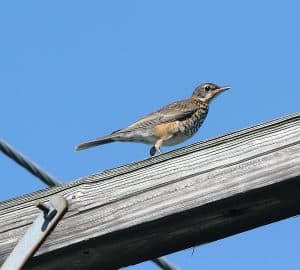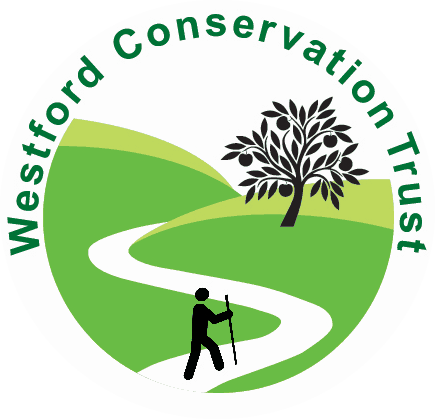
You may have heard by now the sad news that birds are experiencing a new, mystery illness. The illness is progressing through Texas, the Mid-Atlantic states and up the east coast. As of this writing it is said to have come as far north as northern New Jersey, and not yet in New England. However, I have recently received reports of two birds in Westford that might have been sick with this disease. As a preemptive precaution, MassWildlife and Mass Audubon officials are recommending that we take down our feeders, including hummingbird feeders, until further notice. Feeders concentrate birds in one place, and thus help to spread contagious diseases. Fortunately, birds can find plenty of natural food at this time of year.
Birds with this disease have been arriving in yards with crusty swollen eyes, blindness, staggering, disorientation and other neurological symptoms, leading to death. It seems mostly to be fledgling starlings, grackles, blue jays and robins that exhibit these symptoms. Peter Mara of Georgetown University reports on WBUR’s “On Point” that it is not known yet what is causing this, despite biologists efforts to diagnose the problem. They can tell us what is it not. It is not the eye disease that has been plaguing finches for the past few years, finch conjunctivitis. It is not Salmonella, avian flu, West Nile virus or Newcastle disease.
Many articles about this new phenomenon have appeared in Mass Audubon’s nature blog “Your Great Outdoors”, the Boston Globe, WBUR’s “On Point ” program, and in other media outlets.
Mass Audubon advises six actions to take immediately:
1.Cease feeding birds until this wildlife morbidity/mortality event subsides.
2. Clean feeders and bird baths with a 10% bleach solution (one part bleach mixed with nine parts water), rinse with water, and allow to air-dry.
3. Avoid handling birds unless necessary. If you do handle them, wear disposable gloves and wash hands afterwards.
4. If picking up a dead bird, place an inverted plastic bag over your hand to avoid direct contact with the bird. To dispose of dead birds, place them in a plastic bag, seal, and discard with household trash or alternatively bury them deeply.
5. Keep pets (including pet birds) away from sick or dead wild birds as a standard precaution.
6. Please report any unusual bird deaths to Mass Audubon or MassWildlife at mass.wildlife@mass.gov, with the location, number and species of any sick birds observed. Photos will be welcomed as well. No need to report dead birds where strong evidence links mortality to collison with cars, windows or cat predation.
—————–
Many thanks to all flora/fauna reporters for the month of July. Please send reports by July 26 for inclusion in next month’s column. You can e-mail me at mariancharman@gmail.com, write to me at 7A Old Colony Drive, or call me at 692-3907.
Late May/June Reports:
Kate Hollister, Vine Brook Rd. May 12, Northern oriole–“must be the orange in the suet that enticed it to visit”. May 13, first hummingbird arrived. Single hen turkey visited for a week, then moved on. Usual feeder visitors: downy, hairy and red-bellied woodpeckers, grackles, cardinal, nuthatches, robins, mourning doves, goldfinches, chipping and house sparrows, cowbirds, blackbirds, rabbits, chipmunks, house finches, chickadees, and titmice. Bluebirds nesting at a neighbor’s yard. June: at Emmet Conservation Land, pileated woodpecker, several snapping turtles laying eggs, garter snakes, bull frogs. “I met up with a barred owl guarding the bridge on the Esker Loop. I had to cross, so it flew to a nearby low branch. After I crossed, it swooped down from behind and grabbed my cap! Glad I was wearing one. It dropped the cap. I warily picked it up and went on my way. It must have had either a nearby fledgling or nest.” Vine Brook Rd., usual feeder critters, lots of grackles, rabbits, chipmunks, moles, red fox, garter snakes, cabbage butterflies, milkweed beetles. Found a squashed spotted turtle shell. I think it got run over by a lawn mower. Pete saw a live spotted turtle crossing Assabet Rd. from nearby wetlands, so he moved it out of the way. A broad-winged hawk stood under our feeder for awhile with no luck. House finches made a nest in one of our hanging plants. They do this every year…Three eggs so far.
July Reports:
Mike Killoran, Pine Ridge Rd. July 1. I’ve been seeing some bats since April 24th; three on that day. “I’ve often wondered it they use the Old Arch Bridge as a roost.” Two rabbits in the backyard eating plantain leave daily. “They remind me of an office paper shredder. “The cowbird nestling grew faster than the phoebes and fledged a full week earlier….We had the good luck to be watching as a phoebe nestling left the nest, moved to the edge of the post and flew for the first time. Later in the day it was in the front yard on the ground hunting for food. Glad no cats were around.” Today we noticed the mom was back in the nest and there are another three eggs. No cowbird eggs so far. “The wooden birdhouse finally got a tenant with a pair of house wrens. I can hear the chicks each time an offering of food shows up.”
Marian/Bill Harman, Old Colony Drive. July 4, rose-breasted grosbeak male at the black oil sunflower feeder. July 13, at Graniteville fields, Eastern towhee calling “drink your tea”. July 15, We took down the bird feeders today, including the hummingbird feeder, as recommended by Mass Audubon and Mass Wildlife, due to the mysterious bird disease which may be coming to Massachusetts. Sitting on the deck has lost its color and charm now–we miss “our” birds. July 26, warm, humid, 80’s. There is the beautiful fragrance of blooming sweet pepper bush in the air this morning. This afternoon, a different fragrance. The wind has shifted and we have heavy, smelly smoke from the wildfires in the west. July 28, whenever the winds are from the west, we get the heavy smoke, and the state puts out an air quality alert.
Rosemarie Koester, Providence Rd. July 7, “I was up at the herb garden outside of the Town Museum this morning. Much to my delight, found a number of bees and other little guys buzzing around and visiting the many blooming herbs there. What a great spot for them….The ladies taking care of this garden have done a great job.” [Rosemarie sent photos-MH]
The Fernandes Family, Vineyard Rd. July 10, a young red-tailed hawk sitting on the railing and calling repeatedly. [Flavio sent a photo of this newly fledged hawk waiting for its parents to come feed it-MH].
Elona Hart, July 16. Found a juvenile eastern bluebird on the curb of the road, which has both of its legs paralyzed. It was fully alert and wiling to feed on spiders and other bugs it was offered. Unfortunately the bird passed away the same night and we wonder if it was affected by the mysterious disease reported in the mid-Atlantic states. “Thank you for your recent articles about organic lawn care! We fully agree with your opinion and recently ‘fired’ TruGreen. We’ll see how we manage going forward.”
Ginger Dries, Sherwood Drive. July 19, at the feeders: cardinals, lots of grackles and red-winged blackbirds. Saw a red fox catching squirrels, deer and bobcat seen through the winter. Ginger is distressed at the thought of having to take down her feeders.
Marge Barnett, Crusade Rd. July 23, “I’m excited that my butterfly bush is attracting butterflies and bees. [Marge sent lovely photos of bumblebee, painted lady butterflies and Monarch butterflies on her blossoms-MH].
Sue Thomas, Old Homestead Rd. July 23, “after years of organic yard management, we finally have a bunch of fireflies this year!”
Erika Kohl, Frances Hill Rd. July 24. “We have fireflies in the yard!”
Bob Price, at Stony Brook Road. Lovely Turk’s Cap Lilly is blooming at the edge of Stony Brook, near the bridge [Beautiful photo sent-MH]
Kate Hollister, Vine Brook Rd. July 26, juvenile tree frog and juvenile green frog found near the house. Moved the hummingbird feeder to the deck because the squirrels have learned to guzzle the sugar water. We seem to have two pairs… they don’t like to share the feeder. Released a house wren that got under the cloth covering our cabbages. House sparrows used a hanging plant for a nest site. Four species of bumblebees love our catmint. “Note: Found a robin sitting on the road one day, not moving. Its eye was red so I assumed another bird blinded it. Then I read the article in the Eagle this week about the virus that is killing birds, especially robins. I hope that wasn’t what happened to this bird.”
Marian Harman is a member of the Westford Conservation Trust, a non-profit conservation organization. The Trust welcomes new members and volunteers. Please visit our website at westfordconservationtrust.org, or find us on Facebook.
